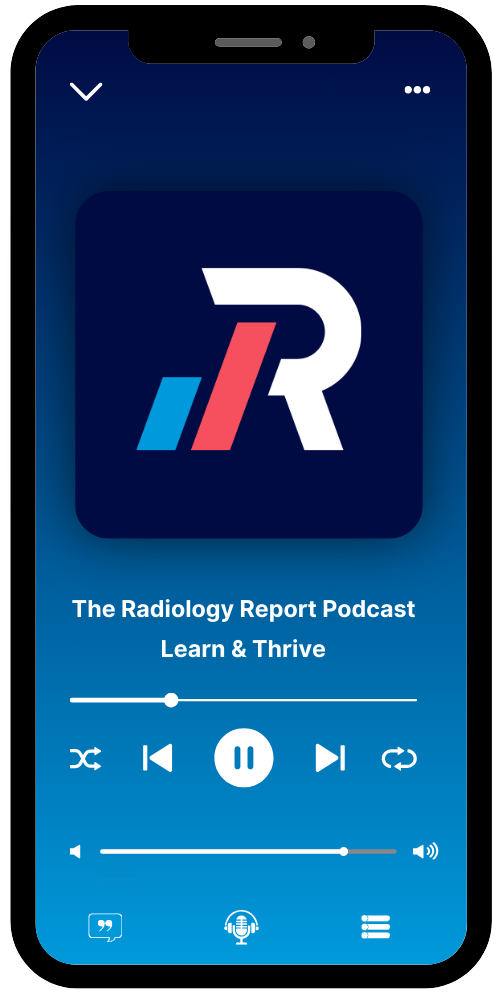Continuing medical education (CME) is a cornerstone of professional development. CME keeps radiologists and allied professionals at the forefront of medical advancements while maintaining their licensure and certifications. Equipping radiologists with the tools to make informed decisions benefits radiology practices and healthcare facilities.
With CME funds operating on a use-it-or-lose-it basis, radiology practices and healthcare facilities must identify strategic opportunities to maximize their value. Selecting cost-effective radiology CME courses and adopting hybrid learning formats helps radiology professionals reach their professional goals without wasting money.
What is radiology CME?
Radiology Continuing Medical Education (CME) is an ongoing educational activity that radiologists complete to maintain and enhance their knowledge, skills, and competence. Radiologists, like other health professionals, commit to lifelong learning to stay current with new techniques, procedures, and other relevant information for improving patient outcomes.
CME funds, also called CME money or CME allowance, are financial resources provided by radiology practices and other healthcare institutions to support radiologists’ continuing education efforts. These funds are typically allocated annually. Radiologists can use them to attend in-person workshops and educational courses, professional conferences, or to study educational materials.
Why radiology CME is important?
Radiology CME is important for several reasons. Completing CME is a requirement for maintaining board certification and licensure. Radiologists must commit to lifelong learning opportunities to stay on top of rapidly advancing medical technology and techniques to remain competitive in their field.
Some radiology practices have additional CME requirements beyond what is necessary for licensure and professional certifications as part of goals for improving patient outcomes.
Annual budget for CME funds
Radiology or healthcare practice size and setting affect the annual budget for radiology CME funds. Private practices typically offer higher allowances to attract top talent, while academic settings provide moderate budgets aligned with the institution’s funding policies. Radiology specialty, geographic location, and individual practice policies can also affect radiology CME stipends.
The typical CME allowance for radiologists ranges between $2,000 to $5,000 annually. This figure has remained relatively steady despite inflation and the rising costs of education.
Most employers require documentation for reimbursement. Some may impose restrictions on fund usage to keep CME stipends aligned with organizational goals.
What is the best radiology CME activity?
There is no one-size-fits-all radiology CME. Radiologists should align their continuing education opportunities with their individual learning preferences, career goals, and any subspecialty interests. Consideration also must be given to any requirements from their employer about how CME stipends can be spent.
Some of the most popular CME learning opportunities include conferences, online learning platforms, subspecialty workshops and hands-on training, professional radiology memberships, and journal subscriptions.
Radiology conferences
Radiology conferences serve as vital hubs for continuing medical education (CME), offering radiologists and allied professionals a wealth of opportunities to stay at the forefront of their field. These gatherings provide a unique blend of cutting-edge research presentations, hands-on workshops, and networking opportunities essential for professional growth.
Some of the most popular radiology conferences include:
Online learning platforms
Online learning platforms are busy radiologists’ best friends. They offer flexible and accessible continuing medical education opportunities that fit into tight schedules.
Medality’s radiology CME online offerings include a diverse selection of content designed to meet the educational needs of radiologists at all career stages. Accredited by the Accreditation Council for Continuing Medical Education (ACCME), these courses provide convenient access to over 700 AMA PRA Category 1 Credits™.
Radiologists can also use these courses to fulfill requirements for ABR Maintenance of Certification, MQSA, SCCT, SCMR, and other professional credentials. The online platform even allows for subspecialty-focused training.
Subspecialty workshops and hands-on training
Subspecialty workshops and hands-on training have become essential components of continuing medical education for radiologists at all career levels. These focused learning experiences offer radiologists the opportunity to deepen their expertise in specific areas, master new technologies, and refine their diagnostic skills.
Mini fellowships offer hands-on training and one-on-one mentoring with experienced radiologists. Some institutions offer subspecialty-specific courses focused on areas like musculoskeletal imaging, neuroradiology, and interventional radiology techniques.
Professional radiology memberships
Professional radiology memberships have become indispensable tools for radiologists seeking to advance their careers, stay current with the latest developments, and fulfill their CME requirements. Some organizations offer more benefits than others.
One of the most popular is the American College of Radiology (ACR). The ACR remains popular among radiologists for its wealth of educational resources, including a minimum of 73 hours of online CME and SA-CME activities annually valued at over $2,000. Members can participate in networking events and state chapter meetings. The ACR also serves as radiology’s official voice on Capitol Hill.
Journal subscriptions
Journal subscriptions remain an accepted option among radiologists for offering a wealth of knowledge and opportunities for professional growth. These publications include the latest research and innovative ways to earn CME credits.
Two prominent examples stand out in the radiology field as go-to sources:
What are some tips for radiologists new to CME funds?
Even when they’re a perk of the job, figuring out which resources to spend those CME funds on can add layers of frustration to the process. Radiologists fresh out of residency or transitioning to a new practice may struggle with using their CME stipends to support their career goals.
Some radiology practices and healthcare facilities may provide guidance, while others leave radiology staff to their own devices. The following strategies help radiologists plan and prioritize their educational activities, learn how to discuss CME allocations with their employers, and track and document CME expenses for seamless reimbursement.
Planning and prioritizing CME activities
Evaluating strengths and weaknesses is an important part of planning and prioritizing CME activities. Seeking informal peer feedback and relying on formal assessment tools provided by radiology medical boards can help with the determination.
Once radiologists have this information, they can use it to establish short-term and long-term objectives targeting specific knowledge or skill gaps. Consider focusing on niche areas such as emerging technologies or updated treatment guidelines.
Don’t be afraid to explore diverse learning formats. Conferences, online modules, and journal subscriptions deliver continuing education differently. Radiologists can find the model that best fits their learning styles and schedules.
Lastly, block dedicated CME time off in your schedule and arrange clinical duty coverage for longer programs.
Discussing CME allocation
Discussing CME allocation with employers helps radiologists maximize their educational opportunities and professional growth. However, this conversation can sometimes present challenges. Some common roadblocks include budget constraints, inflexible CME policies, and in-house training preferences.
Anticipating these potential roadblocks and preparing thoughtful sessions help radiologists approach CME allocation discussions with confidence. Plus, they increase their chances of securing the support needed for continued professional development.
Here’s how:
Tracking and documenting CME expenses
The responsible part of using CME stipends is tracking and documenting those expenses for reimbursement purposes. Maintaining meticulous records is not just a matter of financial prudence. It's an essential aspect of professional development and compliance.
Proper documentation serves multiple purposes. It ensures full reimbursement of your CME expenses, provides a clear overview of your educational journey, and simplifies the process of reporting credits to licensing boards and professional organizations. Well-maintained CME records can protect radiologists in case of any discrepancies or inquiries.
Keep detailed records
Maintaining a comprehensive log of all CME activities is the foundation of effective expense tracking. This log should include:
Consider using a digital spreadsheet or dedicated CME tracking app to maintain this log. Update it regularly, ideally immediately after completing each CME activity.
Organize receipts
Creating an efficient system for storing and categorizing radiology CME-related expenses makes for a smoother reimbursement process.
Some tips for keeping your documents in order include:
Understand reimbursement policies
Radiologists must familiarize themselves with their employers’ specific requirements for CME expense submission and reimbursement. Request a detailed copy of the policy if one wasn’t provided upon hiring. Learn the rules for claiming eligible expenses, how to submit claims in the correct format, and meet all necessary deadlines.
Submit timely reports
Pay close attention to submission deadlines to avoid the risk of non-reimbursement. Use a digital calendar to set alerts and reminders for approaching deadlines. Prepare reports well in advance of the deadline to allow time for any corrections or additional documentation.
Once submitted, follow up to verify the report was received and processed correctly. If any issues arise with payment address them promptly.
How do you maximize radiology CME funds?
Maximizing radiology CME funds requires strategic planning and careful consideration of available options.
When selecting CME resources, focus on high-yield options that provide the most educational value for the investment. Choose comprehensive platforms that include courses that cover multiple subspecialties.
Some other strategies that help radiologists maximize their CME stipends include:
Why Medality is the best choice for radiology CME?
Medality’s focus on practice development, coupled with its extensive library of case-based content and flexible learning options, makes it a top choice for radiologists interested in high-quality, convenient, and cost-effective CME solutions.
Radiologists can access over 4,000 peer-reviewed DICOM cases across imaging modalities and subspecialties. This case-based approach simulates clinical practice, allowing radiologists to gain hands-on experience in several scenarios. The platform features expert-led case reviews and lectures designed to improve diagnostic skills and build confidence.
Other benefits include:
Spend your CME funds efficiently
Maximizing the value of radiology CME funds is about more than fulfilling requirements. It’s about investing strategically in professional growth and improving patient outcomes. Radiologists and radiology practices can make the most of educational opportunities while managing resources effectively.
Prioritizing learning needs, balancing cost and value, using in-person and online platforms, and taking advantage of bundled offers and annual subscriptions are a few of the ways to make every dollar count.
Sources:




